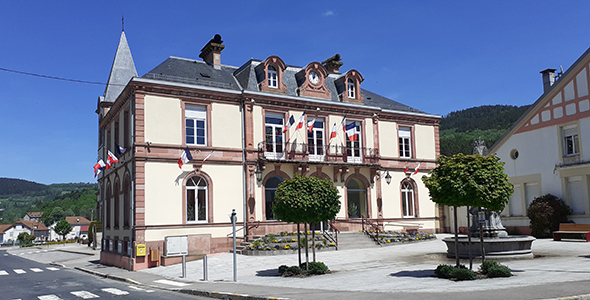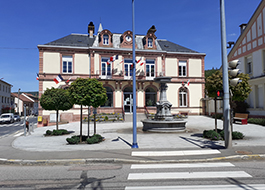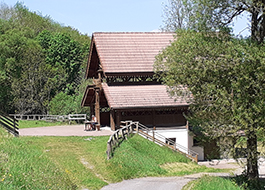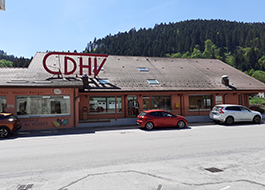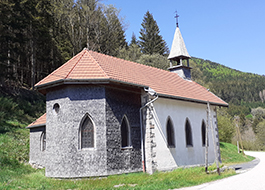Plainfaing
Durée visite : 60 minutes
Moyen : Pédestre
La lignée comtale des Ribeaupierre, au service des ducs de Lorraine, contrôle une partie de la région. Au spirituel, Plainfaing dépend de la grande paroisse de Fraize, qui est le centre religieux de cette partie de la vallée, avec son église et son cimetière, au moins depuis le XIIIe siècle. En 1530, Jean Herquel, chanoine de Saint-Dié, reconstruit prés d’une source une chapelle, dédiée à saint Genest. Elle attire de plus en plus de pèlerins. L’eau de la source, analysée avant 1900, montre une forte teneur en calcium, magnésium et sodium, assez rare en contrée granito-gneissique. En 1783, l’église, dédiée à saint Nicolas, prend la place de l’ancienne chapelle. A cette date le village de Plainfaing était composé de 337 foyers fiscaux, auxquels s’adjoignent 75 pauvres. La commune apparaît après 1790. Avant 1900, les habitants étaient dispersés sur tout le ban communal. C’est l’industrie textile, notamment l’entreprise Geliot, qui entraîne tout au long du XIXe siècle le développement de la commune. La population de Plainfaing culminera à 5 300 habitants en 1905. Le maire et industriel Geliot développa ce qu’on a appelé, plus tard, le paternalisme patronal. L’activité s’arrêtera brutalement avec la fermeture de toutes les usines, en 1970.
The count line of Ribeaupierre, in the service of the Dukes of Lorraine, controls part of the Ban de Fraize. From a spiritual point of view, the village depends on the large parish of Fraize which is the religious center of this part of the valley with its church and its cemetery, at least since the 13th century. In 1530, Jean Herquel, canon of Saint-Dié, rebuilt near a source a chapel dedicated to Saint Genest. It is again attracting more and more pilgrims. The spring water analyzed before 1900 shows a high content of calcium, magnesium and sodium, quite rare in the Granito-Gneiss region. In 1783, the church, dedicated to Saint Nicolas, took the place of the old chapel. At this date the village of Plainfaing was made up of 337 fiscal households (heads of families), to which 75 poor people were added. The town appeared after 1790. Before 1900, the inhabitants were scattered over the entire surface of the town. It is the textile industry, in particular the Geliot company, which drives the development of the town throughout the 19th century. The population of Plainfaing peaked at 5,300 inhabitants in 1905. The mayor and industrialist Geliot developed what was later called employer paternalism. Activity came to an abrupt halt with the closure of all factories in 1970.
Die Zähllinie von Ribeaupierre im Dienste der Herzöge von Lothringen kontrolliert einen Teil des Ban de Fraize. Auf der spirituellen Seite hängt das Dorf von der großen Gemeinde Fraize ab, die mindestens seit dem 13. Jahrhundert das religiöse Zentrum dieses Teils des Tals mit seiner Kirche und ihrem Friedhof ist. Im Jahr 1530 baute Jean Herquel, Kanoniker von Saint-Dié, in der Nähe einer Quelle eine Kapelle um, die dem Heiligen Genest gewidmet war. Es zieht wieder immer mehr Pilger an. Das vor 1900 analysierte Quellwasser weist einen hohen Gehalt an Kalzium, Magnesium und Natrium auf, der in der Region Granito-Gneis recht selten ist. 1783 trat die dem Heiligen Nikolaus geweihte Kirche an die Stelle der alten Kapelle. Zu diesem Zeitpunkt bestand das Dorf Plainfaing aus 337 Steuerhaushalten (Familienoberhäuptern), zu denen 75 arme Menschen hinzukamen. Die Stadt erschien nach 1790. Vor 1900 waren die Einwohner über die gesamte Oberfläche der Stadt verstreut. Es ist die Textilindustrie, insbesondere die Firma Geliot, die die Entwicklung der Stadt im Laufe des 19. Jahrhunderts vorantreibt. Die Bevölkerung von Plainfaing erreichte 1905 einen Höchststand von 5.300 Einwohnern. Der Bürgermeister und Industrielle Geliot entwickelte das, was war später als Paternalismus des Arbeitgebers bezeichnet. Mit der Schließung aller Fabriken im Jahr 1970 kam die Aktivität abrupt zum Erliegen.

Tiercé en pairle au 1° de gueules à trois auréoles de saints d’or, au 2° d’or au sapin de sinople et au 3° d’azur au coq de bruyère d’or.
Les auréoles de saints représentent Saint Louis, Saint Nicolas et Saint Genest particulièrement honorés dans la paroisse. Le sapin et le coq de bruyère évoquent la flore et la faune de la commune.
Tierced in pair to 1 ° Gules with three halos of saints in gold, 2 ° of gold to the pine tree Vert and 3 ° Azure to the rooster of gold briar .
The halos of saints represent Saint Louis, Saint Nicolas and Saint Genest particularly honored in the parish. The fir tree and the heather cock evoke the flora and fauna of the town.
Paarweise abgestuft auf 1 ° Gules mit drei goldenen Heiligenscheinen 2 ° aus Gold auf die Kiefer Vert und 3 ° Azurblau auf den Hahn des Dornes.
Die Heiligenscheine repräsentieren Saint Louis, Saint Nicolas und Saint Genest, die in der Pfarrei besonders geehrt werden. Der Tannenbaum und der Heidehahn erinnern an die Flora und Fauna der Stadt.

Les habitants de Plainfaing s’appellent les Plainfinois et les Plainfinoises.
The inhabitants of Plainfaing are called Plainfinois and Plainfinoises.
Die Bewohner von Plainfaing heißen Plainfinois und Plainfinoises.
Les points de visites
.
L’hôtel de ville comme l’école ont été édifiés en 1870, sous le mandat de Nicolas Géliot. Ce dernier est un homme politique français, né en 1805 en Côte-d’Or et décédé en 1873, à Plainfaing. Manufacturier, commandant de la garde nationale et maire de Plainfaing en 1848, il est conseiller général du canton de 1855 à 1870. Député des Vosges de 1867 à 1870, il siège dans la majorité dynastique, soutenant le Second Empire. Son fils lui a succédé à la mairie. Ce bâtiment témoigne de la puissance de cette famille d’industriels. A côté de la mairie se trouve le monument aux morts. Ce pilier en granit, avec colonne quadrangulaire, est orné de guirlande. Il est surmonté d’un coq. Il rend hommage aux 282 enfants de la commune, morts durant les conflits mondiaux et coloniaux du XXe siècle.
The town hall as the school were built in 1870, under the mandate of Nicolas Géliot. The latter is a French politician, born in 1805 in Peutgey (Côte-d’Or) and died in 1873 in Plainfaing. Manufacturer, commander of the national guard and mayor of Plainfaing in 1848, he was general councilor of the canton of Fraize from 1855 to 1870. Deputy of the Vosges from 1867 to 1870, he sat in the dynastic majority, supporting the Second Empire. His son succeeded him to the city hall. This building testifies by its general appearance of the power of this family of industrialists in the region. Next to the town hall is the war memorial. This granite pillar with quadrangular column is decorated with a garland. It is surmounted by a rooster. It pays homage to the 282 children of the town who died during the world and colonial conflicts of the 20th century.
Das Rathaus als Schule wurde 1870 unter dem Auftrag von Nicolas Géliot erbaut. Letzterer ist ein französischer Politiker, der 1805 in Peutgey (Côte-d’Or) geboren wurde und 1873 in Plainfaing starb. Von 1855 bis 1870 war er Hersteller, Kommandeur der Nationalgarde und Bürgermeister von Plainfaing. Von 1855 bis 1870 war er Generalrat des Kantons Fraize. Von 1867 bis 1870 war er Abgeordneter der Vogesen und saß in der dynastischen Mehrheit und unterstützte das Zweite Reich. Sein Sohn folgte ihm zum Rathaus. Dieses Gebäude zeugt von seinem allgemeinen Erscheinungsbild der Macht dieser Industriefamilie in der Region. Neben dem Rathaus befindet sich das Kriegsdenkmal. Diese Granitsäule mit viereckiger Säule ist mit einer Girlande verziert. Es wird von einem Hahn überragt. Es ist eine Hommage an die 282 Kinder der Stadt, die während der Welt und der Kolonialkonflikte des 20. Jahrhunderts starben.
.
.
Au 18ème siècle, les Plainfinois demandèrent, en vain, à être détachés de Fraize et à acquérir leur autonomie. Ce qui leur aurait permis de construire leur propre église. Coup de pouce du destin, en février 1782, l’église de Fraize brûla. On donna aux Plainfinois l’accord qu’ils attendaient. L’érection de l’église fut rapide, de même que la démolition de la Chapelle Saint Genest, desservie par les prêtres de Fraize, construite à la fin du XVIIe siècle. En 1884, la réfection de l’église la modifia. On vit la construction de trois nefs et de voûtes intérieures dans un style roman, la confection de meneaux et de vitraux. Ceux-ci, détruits en 1944, furent magnifiquement remplacés. L’orgue actuel a été financé par la veuve de l’industriel Geliot, en 1900. Il a été réalisé par la célèbre entreprise Cavaillé-Coll.
In the 18th century, the Plainfinois asked in vain to be detached from the community of Fraize and to acquire their autonomy. Which would have allowed them to build their own church. Boost of destiny, in February 1782, the church of Fraize burned down. The consequence of this was to give the Plainfinois the agreement they expected. The erection of the church was rapid, as was the demolition of the Saint Genest Chapel, served by the priests of Fraize, built at the end of the 17th century. In 1884, the renovation of the church changed it. We saw the construction of three naves and interior vaults in a Romanesque style, the making of mullions and stained glass. These, destroyed in 1944, were magnificently replaced. The current organ was financed by the widow of the industrialist Geliot in 1900. It was produced by the famous company Cavaillé-Coll.
Im 18. Jahrhundert baten die Plainfinois vergeblich darum, sich von der Gemeinde Fraize zu lösen und ihre Autonomie zu erlangen. Das hätte ihnen erlaubt, ihre eigene Kirche zu bauen. Schicksalsschub, im Februar 1782 brannte die Kirche von Fraize nieder. Die Folge davon war, dass die Plainfinois die erwartete Zustimmung erhielten. Die Errichtung der Kirche erfolgte rasch, ebenso wie der Abriss der Saint-Genest-Kapelle, die Ende des 17. Jahrhunderts von den Priestern von Fraize erbaut wurde. 1884 wurde es durch die Renovierung der Kirche geändert. Wir sahen den Bau von drei Schiffen und Innengewölben im romanischen Stil, die Herstellung von Pfosten und Glasmalereien. Diese 1944 zerstörten wurden prächtig ersetzt. Die heutige Orgel wurde 1900 von der Witwe des Industriellen Geliot finanziert. Sie wurde von der berühmten Firma Cavaillé-Coll hergestellt.
.
Au début du XXe siècle, l’instituteur du village, Aimé Dodin, avait eu l’idée de construire ce bâtiment en bois pour ses élèves. Ainsi ils pourraient profiter pleinement du bon air de la montagne. A cette époque, la tuberculose faisait encore des ravages. En 1985, une association du village, Li Habauré et Compéïe ou les Gens d’Habeaurupt et Compagnie, décida de reconstruire cet édifice qui avait été détruit. Avec une scène pavée et des gradins, pouvant accueillir jusqu’à 600 personnes, un nouveau lieu culturel était créé. En 1997, s’y déroula d’ailleurs le premier festival de théâtre amateur. Mais il s’agit aussi d’un lieu de détente, avec un square pour enfants, des jeux.
At the beginning of the 20th century, the village teacher, Aimé Dodin, had the idea of building this wooden building for his students. So they could take full advantage of the fresh mountain air. At that time tuberculosis was still wreaking havoc. In 1985, a village association, Li Habauré and Compéïe or the People of Habeaurupt and Company, decided to rebuild this building which had been destroyed. With a paved stage and bleachers for up to 600 people, a new cultural place was created. In 1997, the first amateur theater festival took place there. But it is also a place of relaxation, with a children’s square, games.
Zu Beginn des 20. Jahrhunderts hatte der Dorflehrer Aimé Dodin die Idee, dieses Holzgebäude für seine Schüler zu bauen. So konnten sie die frische Bergluft voll ausnutzen. Zu dieser Zeit verursachte die Tuberkulose noch Chaos. 1985 beschloss ein Dorfverband, Li Habauré und Compéïe oder die Leute von Habeaurupt and Company, dieses zerstörte Gebäude wieder aufzubauen. Mit einer gepflasterten Bühne und Tribünen für bis zu 600 Personen wurde ein neuer kultureller Ort geschaffen. 1997 fand dort das erste Amateurtheaterfestival statt. Es ist aber auch ein Ort der Entspannung, mit einem Kinderplatz, Spielen.
.
En 1986, la famille Claudepierre reprend la Confiserie des Images d’Epinal. Elle souhaitait perpétuer la tradition artisanale des véritables bonbons des Vosges.
Aujourd’hui installée à Plainfaing, la nouvelle génération, ses 40 salariés et apprentis, produisent les délices colorés et aromatiques. Près de 300 tonnes de bonbons artisanaux ont été produits en 2015. La Confiserie accueille chaque année plus de 200.000 visiteurs. Ce qui la classe cinquième entreprise la plus visitée en France, première dans le domaine agroalimentaire. Pour avoir choisi la qualité et la tradition, ses pairs de la confiserie ne s’y sont pas trompés. La Confiserie Des Hautes Vosges fait partie des 4 privilégiés lorrains, qui détiennent l’Indication Géographique Protégée, pour la Bergamote de Nancy. Sont utilisés des huiles essentielles et des arômes naturels (bourgeons de sapin, eucalyptus, myrtille, framboise, coquelicot, mirabelle, bergamote) des matières premières de proximité (le sucre de betterave de l’Alsacien Erstein et le sirop de glucose de maïs fabriqué à Marckolsheim dans le Bas-Rhin) Le tout est cuit dans un grand chaudron de cuivre, comme les confiseurs d’autrefois. Le coup de main du confiseur pour étaler, malaxer, découper et former les bonbons impressionne tous les visiteurs. La Confiserie Des Hautes Vosges a inventé des dosettes de brisures de bonbons. Elles donnent des infusions originales. Les achats se font sur place. Une garantie de plus pour barrer la route aux contrefaçons.
It was in 1986 that the Claudepierre family took over the Confiserie des Images d’Épinal. His desire was to perpetuate the artisanal tradition of genuine Vosges sweets. Now based in Plainfaing, the new generation and their 40 employees and apprentices produce and distribute every day the colorful and aromatic delicacies that adorn the shop with their boxes and bags. Thus, nearly 300 tonnes of artisanal sweets were produced in 2015. The Confiserie des Hautes-Vosges welcomes more than 200,000 visitors each year. This ranks it as the fifth most visited company in France and first in the agri-food sector. For choosing quality and tradition, his confectionery peers were not mistaken. Confiserie Des Hautes Vosges is one of the only 4 manufacturers in Lorraine to hold the Protected Geographical Indication for Bergamot from Nancy. Are used essential oils and natural flavors (fir buds, eucalyptus, blueberry, raspberry, poppy, mirabelle plum, bergamot), local raw materials (beet sugar from Alsace Erstein and corn glucose syrup – GMO-free – made in Marckolsheim in the Bas-Rhin). Everything is cooked in a large copper cauldron, like the confectioners of the past. The confectioner’s helping hand in spreading, kneading, then cutting and shaping the candies impresses all visitors. Confiserie Des Hautes Vosges has invented small pods of broken candies to prepare original infusions. Purchases are made on site or by correspondence or on the website www.cdhv.fr
Another guarantee to block the road to counterfeits.
1986 übernahm die Familie Claudepierre die Confiserie des Images d’Épinal. Sein Wunsch war es, die handwerkliche Tradition echter Vogesen-Süßigkeiten fortzusetzen. Die neue Generation mit Sitz in Plainfaing und ihren 40 Mitarbeitern und Auszubildenden produziert und vertreibt jeden Tag die farbenfrohen und aromatischen Köstlichkeiten, die den Laden mit ihren Kisten und Taschen schmücken. So wurden 2015 fast 300 Tonnen handwerkliche Süßigkeiten hergestellt. Die Confiserie des Hautes-Vosges begrüßt jedes Jahr mehr als 200.000 Besucher. Damit ist es das fünfthäufigste Unternehmen in Frankreich und das erste im Agrarlebensmittelsektor. Bei der Wahl von Qualität und Tradition täuschten sich seine Kollegen aus der Konditorei nicht. Die Confiserie Des Hautes Vosges ist einer der wenigen Hersteller in Lothringen, die die geschützte geografische Angabe für Bergamotte von Nancy besitzen. Verwendet werden ätherische Öle und natürliche Aromen (Fichtenknospen, Eukalyptus, Blaubeere, Himbeere, Mohn, Mirabellenpflaume, Bergamotte), lokale Rohstoffe (Rübenzucker aus dem Elsass Erstein und Maisglukosesirup – GVO-frei – hergestellt in Marckolsheim im Bas-Rhin). Alles wird in einem großen Kupferkessel gekocht, wie die Konditoren der Vergangenheit. Die helfende Hand des Konditors beim Verteilen, Kneten, Schneiden und Formen der Süßigkeiten beeindruckt alle Besucher. Die Confiserie Des Hautes Vosges hat kleine Schoten mit zerbrochenen Süßigkeiten erfunden, um Originalinfusionen herzustellen. Einkäufe werden vor Ort oder auf dem Schriftweg oder auf der Website www.cdhv.fr getätigt Eine weitere Garantie, um den Weg zu Fälschungen zu blockieren.
.
A l’origine, il y avait un ermitage devant l’Etang des Dames. Une chapelle fut construite sur son emplacement au XVIIe siècle. La famille Lesseux l’a reconstruite en face, au pied de la colline et l’a entretenue depuis. Lors de la guerre de 14-18, ses abords servirent de cimetière militaire provisoire. La seconde guerre mondiale l’a endommagée. Depuis on a reconstruit son clocher, autrefois néo-gothique, en essis de bois, nom vosgien pour bardeaux ou travaillons. Au sommet, la croix en fer est dominée par l’effigie d’un Grand Tétras.
Originally, there was a hermitage in front of the Etang des Dames. A chapel was built on its site in the 17th century. The Lesseux family rebuilt it opposite, at the foot of the hill and have maintained it ever since. During the war of 14-18, its surroundings served as a provisional military cemetery. The Second World War damaged it. Since then we have rebuilt its steeple, formerly neo-Gothic, in wooden essis, Vosges name for shingles or work. At the top, the iron cross is dominated by the effigy of a Capercaillie.
Ursprünglich gab es eine Einsiedelei vor dem Etang des Dames. An dieser Stelle wurde im 17. Jahrhundert eine Kapelle errichtet. Die Familie Lesseux hat es gegenüber am Fuße des Hügels wieder aufgebaut und seitdem gepflegt. Während des Krieges von 14 bis 18 diente seine Umgebung als provisorischer Militärfriedhof. Der Zweite Weltkrieg hat es beschädigt. Seitdem haben wir seinen ehemals neugotischen Kirchturm in hölzernem Essis umgebaut, dem Namen der Vogesen für Schindeln oder Arbeiten. Oben dominiert das Eisenkreuz das Bildnis eines Auerhuhns.

